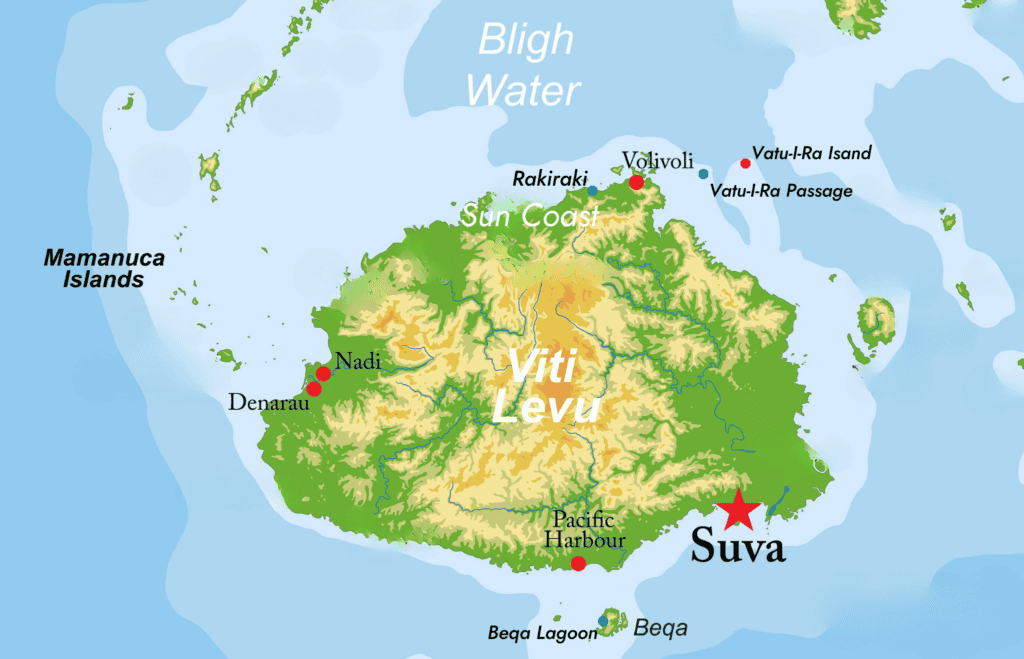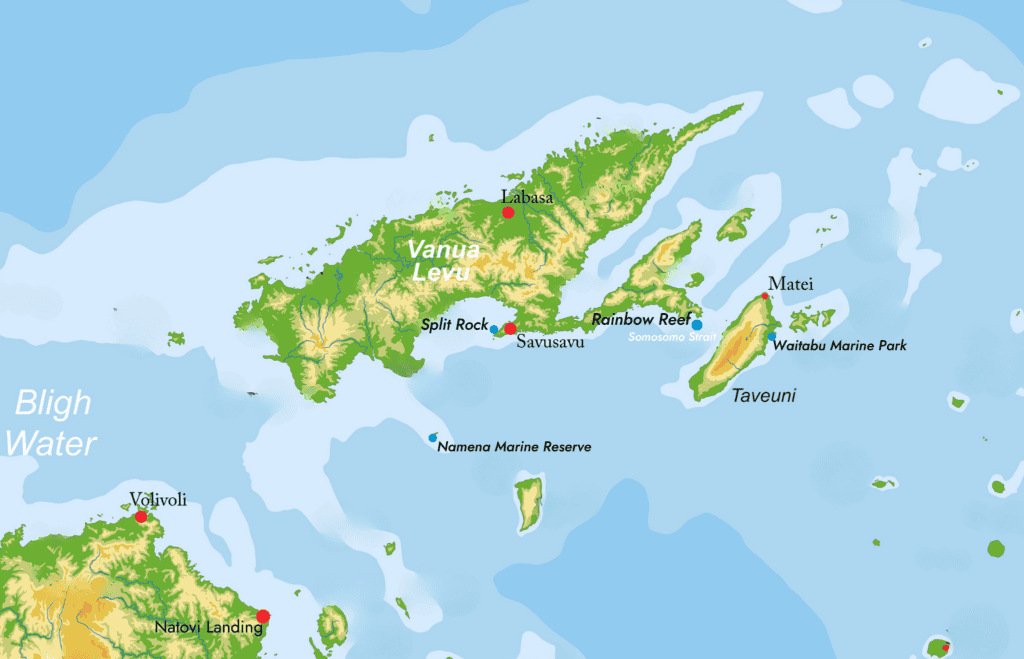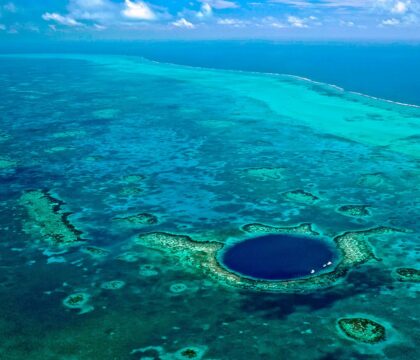April 2, 2024 • Travel Ideas
Fiji may be best known as a honeymoon getaway thanks to its stunning beaches and high-end resorts, but hidden beneath the waves are some of the most beautiful marine ecosystems in the world. Over 4,000 square miles of coral reefs sprawl across more than 300 islands offering unforgettable island-hopping adventures brimming with snorkeling opportunities.
Whether you want to snorkel in Fiji’s palm-shaded lagoons or amongst walls of soft-coral plunging to ocean depths, there’s an adventure for all experience levels.
Planning for Snorkeling in Fiji
The mild year-round climate, refreshing water temperatures (averaging around 79ºF), and consistently crystal-clear visibility make any time a good time to snorkel in Fiji. There are a few sites where ocean currents will attract wildlife at specific seasons (e.g., Manta Ray Passage), but unless otherwise noted, the calendar is wide open.
4,000 square miles of coral reefs is a lot of ocean to cover, so we recommend choosing just one or two regions depending on the length of your visit. Many travelers set up on one of Fiji’s islands- and then embark on snorkel excursions via their accommodation or tour operator. Or, better yet, choose an expert guided, small-group Fiji snorkeling trip that will allow you to visit the highlights while saving you from researching and managing logistics.

Fiji has many coral reefs that are ideal for snorkeling. © Pete Oxford
Snorkeling in Fiji: The Must See Highlights
To experience the best of snorkeling in Fiji with limited time, here are our top sites:
- Taveuni Island: The “garden island” of Fiji sits atop a shield volcano with a white-sand coast lined by coral reefs. Volcanic-rich soil also laid the foundation for jungle-clad parks that cover over one-third of the island. Find lodging at Paradise Taveuni, enjoy the plethora of reefs available by beach or boat, such as the legendary Rainbow Reef which is in striking distance.
- Rainbow Reef: Renowned oceanographer Jacques Cousteau deemed the Rainbow Reef the “soft coral capital of the world” after viewing the famous cliffs of flowing coral, like the Great White Wall, which plunges over 130 feet into the abyss. The Rainbow Reef complex spans over 4,000 square kilometers and is home to 1,200 exotic fish species. Numerous world-class snorkel sites are sprinkled throughout, including “the Zoo” – famous for pelagics, such as barracudas, trevallies, moray eels, and groupers.
- Beqa Lagoon: Easily accessible off of the southern coast of the mainland, Beqa Lagoon sits at the heart of one of the largest barrier reefs in the world. Set up an adventure hub at the Beqa Lagoon Resort for easy access to palm-shaded shallow water snorkeling, or take an excursion out to snorkel with the abundant reef sharks in the area.
A Fiji snorkeling trip with Oceanic Society ensures you hit the highlights. But, for those that want to go it alone, in the following sections we provide a high-level overview of the best snorkeling sites in Fiji, organized by region, with tips for each.
See a Sample Fiji Snorkeling Itinerary
Northwest: Mamanuca and Yasawa Archipelago
Best snorkeling in Fiji for families and beginners. For those looking for the quintessential Fijian ocean adventure, there are few better places to go than this northwestern chain of islands – a region renowned for calm, clear waters, white-sand beaches, and a variety of beach and boat accessible reefs for snorkeling.

Fiji’s northwestern archipelago is dotted with numerous pristine coral reefs, perfect for snorkeling.
Most travelers arrive using the Yasawa Flyer, a ferry service that leaves daily from Denarau Marina on the west coast of Fiji’s mainland, near Nadi and the international airport, stopping at 20 islands throughout the Mamanuca and Yasawa chain. Accommodations across the islands widely vary from luxury resorts to bustling backpacker hostels. Thankfully, crowds split across the islands, meaning you can easily find a quiet corner, or the party – whatever the preference.
Malolo Lailai: If you are based on the island, you will have no trouble finding vibrant, beach-accessible reefs and viewing diverse wildlife – sea turtles, reef sharks, rays, and more – who dwell amongst the calm, clear waters of Malolo.
- Where: Quick 1-hour boat ride from either Denarau Marina or Lautoka. The island is small, just under 5 square miles, perfect for daily snorkeling expeditions.
- Who: An ideal introduction to Fiji for anyone looking to casually enjoy Fiji’s legendary waterworld.
Blue Lagoon: Sapphire water tucked in a palm-shaded lagoon offers a gateway to a vibrant shallow reef teeming with tropical fish.
- Where: The lagoon is situated on Nanuya Lailai Island, which – like Malolo – is easily accessible by boat from Denarau Marina or Lautoka.
- Who: Well-developed infrastructure and calm, shallow waters makes the Blue Lagoon a top choice for families with young children looking to snorkel in Fiji.
Drawaqa Island: Renowned for viewing the majestic giant manta rays at the nearby Manta Ray Passage, especially from May to October, when currents bring abundant food.
- Where: Manta Ray Passage is situated between Naviti and Drawaqa Island, visiting the passage is typically done through an organized tour, with many departing from Drawaqa Island. Be sure to arrange with a trusted tour operator to ensure wildlife is not disturbed.
- Who: Water depth varies, offering opportunities to both snorkelers and divers. Currents can be strong, so this option is more suited to intermediate swimmers.
Moyia Reef: Tucked on an uninhabited island, famous for the pristine quality of the reef and abundant (harmless!) reef sharks, who commonly feed in the area from January to April.
- Where: Tours are required to visit and can easily be organized through accommodations or tour agencies. Trips are commonly organized from Kuanta Island, which is only a 20-minute boat ride away.
- Who: Isolation makes this a good option to escape the crowds. Ideal for intermediate or experienced snorkelers comfortable with currents and proximity with sharks.
Nacula Island: Easy access to a network of both soft and hard coral reefs with excellent water visibility.
- Where: More remote than comparable island hub alternatives, Nacula is a 4-hour ferry ride from the most common departure point, Denarau Marina.
- Who: Its location typically means fewer people. Surrounding currents can be strong, catering more to intermediate snorkelers.
Sawa-i-Lau Caves: Limestone carved arches, chambers, tunnels, and lagoons rising from the ocean floor, offering intrepid snorkelers an unforgettable aquatic adventure. The chamber acoustics birthed local legends, one of which tells of mermaids singing to lure lonely fishermen.
- Where: Operators across the Yasawa Islands offer guided boat tours to the caves, which often include stops for snorkeling, swimming, or beach excursions along the way.
- Who: Tours typically include experiences for anyone, but competent swimmers will be able to make the most of the various aquatic chambers.
Mainland: Viti Levu
Best snorkeling in Fiji for convenience: Reefs on or near Fiji’s mainland, Viti Levu, are perfect for those looking to tack on snorkeling to their Fiji adventure. Once you touchdown in Nadi or Suva, whatever the itinerary – whether you are heading north to explore Fiji’s Sun Coast or heading to the remote southern reaches (see section, South: Kadavu) – be sure to dedicate a few days to explore the mainland’s underrated marine ecosystems before or after you visit the more coveted remote corners of Fiji.

Fiji’s mainland can provide some convenient snorkeling options before or after exploring the more remote islands.
Beqa Lagoon: The lagoon sits at the heart of the Beqa Island group, one of the largest barrier reefs in the world with 190 miles of coral and a plethora of wildlife. Shark enthusiasts can dive amongst schools of bull and tiger sharks who commonly gather.
- Where: Visiting Beqa Lagoon requires a tour operator, but it is just 45-minutes by boat from Pacific Harbor, a popular hub on the southern coast of Viti Levu (~3 hour drive from Nadi). Consider lodging on Beqa Island for full immersion.
- Who: Abundant house reefs, boat tours, and diving opportunities means there is an experience for everyone, from beginner snorkelers to expert divers.
Rakiraki: An opportunity to explore some of the island’s healthiest coral reefs, lined by sprawling white-sand beaches, without the crowds.
- Where: Nestled two hours away from Nadi on the northeast “Sun Coast” of Viti Levu, Rakiraki can easily slot into a mainland itinerary.
- Who: Convenience and quiet paired with calm waters make this the perfect spot for families to indulge in a quiet Fijian snorkeling getaway. Boat tours to outer reefs offer intermediate snorkelers adventures as well.
Vatu-I-Ra Passage: An ocean channel famous for its purple and pink coral and nutrient rich waters that attract abundant ocean life, including sharks, giant clams, rays, and sea turtles. The passage is part of the Vatu-I-Ra Conservation Park, including Vatu-I-Ra Island, which is loaded with top snorkeling sites. If you are visiting between August and October, you may even witness humpback whales in this migration corridor.
- Where: The passage nestles between VoliVoli and Vatu-I-Ra Island, within the greater Bligh Waters region off the sun coast of Viti Levu. Tours are also commonly organized from Rakiraki.
- Who: A wide variety of water depths in the passage offers snorkeling experiences for all levels, beginners to experts.
Northeast: Vanua Levu and Taveuni
Best snorkeling in Fiji for biodiversity: The northeastern islands, Vanua Levu and Taveuni, hold some of the most pristine sanctuaries for snorkeling in Fiji due to their remoteness, nutrient rich tides, and longstanding environmental protection enforced by the local community.

Fiji’s northeastern islands are renowned for snorkeling and the health of their coral reefs.
A domestic flight from Nadi to Labasa, Vanua Levu or Matei, Taveuni is the quickest route. Otherwise, ferries from Natovi Landing on the east coast of the mainland to Savusavu, Vanua Levu will take around 4 hours. The ferry from Suva to Taveuni Island takes ~13 hours and is not for the sea-sick prone. Once on Vanua Levu or Taveuni, accommodations vary, ranging from eco-lodges to boutique hotels, with price points available for all budgets.
Rainbow Reef: Deemed the “soft coral capital of the world” by legendary oceanographer Jacques Cousteau, who was awestruck by the sprawling walls of soft coral – such as the Great White Wall, which plunges 131 feet deep and shelters countless tropical fish.
- Where: Located in the Somosomo Strait between Vanua Levu and Taveuni. Boat tours are required to explore the Rainbow Reef and its popular snorkel sites, such as the Great White Wall, the Zoo (famous for abundant wildlife) and the Cabbage Patch (known for coral formations that resemble its namesake). Tours are commonly organized from both Vanua Levu and Taveuni.
- Who: Snorkel sites vary in water depth and current strength, so there is typically an option for all experience levels.
Namena Marine Reserve: Designated as a Marine Protected Area (MPA) since 1997 (placing a total ban on fishing) following rampant commercial fishing, Namena is now home to more than 1,100 species of fish, including sharks. If you are lucky, you may see humpback whales who raise their calves (especially from August-October) in these nutrient rich waters
- Where: The park is located on the uninhabited Namena Island off the south coast of Vanua Levu. The best way to visit is through a tour operator, which can usually be arranged from accommodations based on Vanua Levu or Savusavu.
- Who: Varying water depth and current strength across the numerous snorkel sites within the park means that there is a suitable snorkel excursion for all experience levels.
Waitabu Marine Park: Like Namena, Waitabu has been designated as a MPA since the 1990s and has turned into a complex of healthy coral reefs. The local community manages the park through Waitabu Marine Park Trust, and offers eco-tours for curious travelers looking to learn about local conservation efforts and while experiencing the full breadth of the park.
- Where: The MPA covers approximately 356 acres of land on Taveuni, making it easy to explore while staying on the island.
- Who: Numerous snorkeling locations – including shallow, shore accessible reefs as well as boat tours and dive spots – cater to all experience levels.
Split Rock: An obscure lava formation appearing like a gash across a pinnacle of rock, creating a canyon of coral. Divers can swim through the gap. Split Rock regularly attracts a diverse array of marine life: tropical fish, snappers, reef sharks, eels, rays are commonly seen.
- Where: Situated just east of Savusavu on Vanua Levu. Boat tours, usually departing from Savusavu, are required to visit Split Rock.
- Who: While primarily a dive site due its depth and strong currents, snorkeling is possible in the area surrounding the pinnacle for those who are comfortable swimmers.
South: Kadavu
Best snorkeling in Fiji for hidden gems: Nestled in the southern reaches of Fiji’s archipelago lies Kadavu, a jungle-clad island renowned for its rugged beauty and untouched marine environments. Often overshadowed by more popular tourist destinations, Kadavu offers adventurous travelers a unique off the beaten path experience and some of the best snorkeling in Fiji, while surrounded by dramatic landscapes and lush marine wildlife.

The southern islands may be more remote, but offer some of the best snorkeling in Fiji.
Getting to Kadavu typically requires a quick ~45-minute domestic flight from either Nadi or Suva to Vunisea. Otherwise, a ferry runs between Suva and Vunisea or Kavala, and takes ~5.5 hours. Be warned: the waters of the Kadavu Passage are notoriously rough, so be sure to come prepared for a choppy journey. Accommodation options are more limited than other well-worn islands, but there are a handful of eco-friendly resorts, guesthouses, and even homestays that offer laid-back atmospheres and connection with the local community. Kadavu is accessible by domestic flights.
Great Astrolabe Reef: The 4th largest barrier reef in the world stretching along the eastern coast of Kadavu. The barrier reef is situated amongst a network of passages with strong currents, creating a breeding ground for big giants: marlin, tuna, giant trevally, and sharks are commonly seen. If you’re lucky, you may even see dolphins and whales.
- Where: Consider staying on Ono Island, an isolated paradise situated near the Great Astrolabe Reef, and only a 10-minute boat ride to a cleaning station where manta rays are tended to by local wrasse.
- Who: With hundreds of snorkel sites to choose from, there are experiences for all kinds of snorkelers.
Snorkeling in Fiji with Oceanic Society
Explore Fiji with Oceanic Society for an unforgettable ocean adventure taking travelers to a selection of handpicked snorkel sites, including the Rainbow Reef, Beqa Lagoon, and the incredible house reefs of Sau Bay. For a comprehensive South Pacific ocean adventure, consider combining a trip to Fiji with Tonga for the rare opportunity to swim amongst humpback whales.
Oceanic Society has been leading sustainable snorkeling tours for 50 years. Our team of naturalists have deep roots with the environments we visit, ensuring our interactions with wildlife are ethical, respectful, and benefit the ecosystems and economies we visit. As a bonus, each traveler booking a multi-day trip with Oceanic Society directly sponsors the removal of 200 lbs. of plastic waste from the ocean as part of our ongoing fight against ocean pollution.




